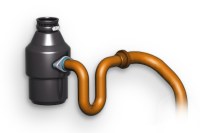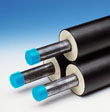Technologies
micro CHP based on high temperature SOFC
Micro-co-generation systems, producing both heat and electricity in a certain ratio to each other, provide potential reductions in carbon emissions and costs by generating both heat and electricity locally with efficient fuel use and by offsetting the use of centrally-generated electricity from the grid.
The major benefits of distributed generation systems are savings in losses over the long transmission and distribution lines, installation cost, local voltage regulation, and ability to add a small unit instead of a larger one during peak load conditions.
Fuel cell-based micro CHP systems may also offer higher carbon savings due to their potential to operate with higher electrical efficiencies. Improved efficiency of the micro CHP SOFC (current total efficiency up to 85%, target through integration of components up to 90%) will lead to direct reduction of fuel consumption. The optimized micro CHP featuring high efficiency peripheries (improved balance-of-plant (BoP, simplified unit architecture and start-up procedure) will allow tri-generative use (power/heating/cooling) at building level and interconnection with a district heat distribution system and an electrical micro-grid. A 2,5 kW SOFC stack will constitute the core part of the FC-DISRTICT system.
Research tasks related to SOFC technology within FC-DISTRICT are focused on development of district interface that is: interconnections, operation parameters and proper control procedures. The range of research is to adapt, optimize and manufacture a number of SOFC based micro CHP units able to deliver 2 kW electric power and 6 – 8 kW thermal power, with an overall efficiency up to 90%, allowing: Trigenerative use (power/heating/cooling) at building level Inter-connection with a district heat distribution system and an electrical micro-grid.
biogas production through exploitation of food waste
Through the introduction of the upgraded wastes into centralized anaerobic digesters it is possible to integrate the production of biogas. After purification, removal of inerts and sulphur, and deodorization of the biogas derived from such renewable resource, it is possible to be upgraded via injection into the gas grid.
The food waste, which is the most efficient fraction of municipal solid waste for the production of biogas, is therefore exploited, collected in a controlled and automatic way by means of the use of Food Waste Disposers (FWDs) coupled with settler tanks. Such approach is expected to solve the problems connected with a separate collection (e.g. odours, insects, leachate leakages, bacteria proliferation) and it is furthermore simple to operate.FWDs are appliances that at the same time save time to the citizens, are friendly to use and create also the base for a win-win business model. The innovative scheme, in fact, is based on the capability to monitor the amount of wastes conferred and therefore the potential biogas production, providing a reward to the citizens that installed the FWDs in their kitchens according to their contribution to production of bio-energy.
This integrated method is expected to create “sustainable energy districts” through the adoption of conscious and environmentally friendly attitudes, thanks to business models that reward their inhabitants, and the integration of the gas into the grid, to power CHP based networks of SOFC, as developed within the project.
The range of research is to:
- Design and develop a new waste settler and filtering tank which provides compacted dehydrated waste material ready for being digested providing high quality biogas
- Develop a highly efficient, low cost control and monitoring system, enabling the coordinated and wireless management of the wastes generated by the network of FWD and tanks
- Develop a real time waste management framework thanks to the realization of a wireless connection of the tanks with the collecting waste monitoring center, organizing the logistics and transport to the digester
- Establish a win-win business model based on the coordinated use of Food Waste Disposers (FWDs) and settler tanks
- Introduce new management model for food waste collection at district level exploiting the energy content of the waste by means of the anaerobic digestion process
new solutions for thermal storage
The FC-DISTRICT project aim isexploitation of active storage (heat and cooling) at floor, wall and ceiling dry wall systems. The building will act as an active “heat hub” exchanging heat with neighbouring buildings.
The “integrated energy system” will enable circulation of the thermal energy within the building through space and time responding to load variations and taking advantage of this energy that otherwise would be wasted.
The FC-DISTRICT developments in energy storage, cooling, controls, and integration technology will enhance the performance and operation of micro-CHP appliances enabling the user (or energy manager) to run the power unit to produce electricity when heat is not required, store it and to obtain heat when it’s needed without producing electricity.
The range of research is to:
- Develop and upgrade building components and systems to meet the requirements of “high-performance” residential buildings, characterized by a very low space heating load (about 15 kWh/(m2a)) and peak load typically below 10 W/m2.
- Extend of storage systems to meet thermal storage requirements at district level.
district wide distribution networks
Electrical integration at district level can be met using the Virtual Power Plant (VPP), a collection of smaller electricity generating units able to replace a conventional power plant in terms of power output.
The concept of thermal integration at district level with a dynamic load exchange between neighbouring buildings and/or with a central hub is an extension of the VPP concept. This totally innovative approach will be investigated in the framework of FC-DISTRICT.
It is highly promising concept that is directly linked to the maturing of distributed co-generation with use of micro CHP. In order to minimise energy losses from the heat distribution and the efforts required for the installation work, a new heat distribution pipeline concept will be developed based on recent progress in nano-structured thermal insulation.
The range of the research is to optimize and tailor the characteristics of the energy and power distribution systems to meet the district demand.
communication needed for control of the networks
The conventional approach to sensory networks assumes a homogeneous network infrastructurewhereas most real-life scenarios are based upon the use of hybrid networks.
This creates a number of issues related to the reliability of the received data, localization and remote calibration of the sensors and provision of the same quality of service to wireless and wired sensor nodes.
A prototype hybrid network will be developed and implemented within FC-DISTRICT. Data communication requirements will be identified and ranked communication strategy necessary to achieve the desired performance will be deployed.
system integration
Various technologies being developed in are to be integrated in FC-DISTRICT concept at conventional installations and demonstrate the energy saving and management improvements.
The new energy regulated components and energy systems will be installed, monitored and evaluated in two demonstration sites. The aim is to demonstrate the interaction of the SOFC with other devices required for delivering power, heat and cooling and other possible services to end users.



